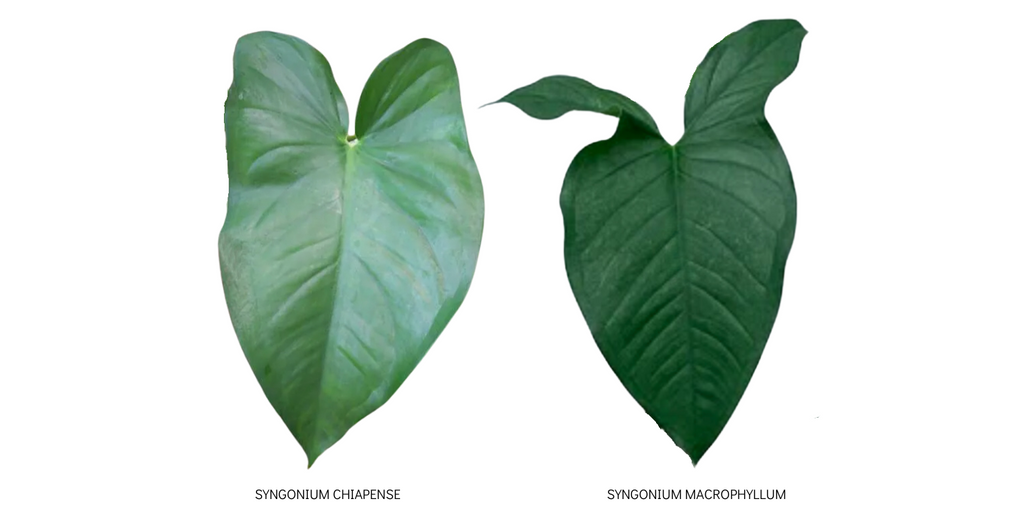Identifying Syngonium chiapense v's Syngonium macrophyllum
By Emma Kelt | 25/01/24
Related: -Syngoinium Plant Care Guide
Spotting The Differences Between The Syngonium chiapense and The Syngonium macrophyllum
The Syngonium, also known as the arrowhead vine, is a popular choice among indoor plant lovers. Surprisingly, there are over 30 species in the Syngonium genus. Two lesser-known species, Syngonium chiapense and Syngonium macrophyllum, share similar juvenile forms but showcase distinct features as they mature. Read on to unravel the differences between these two uncommon arrowhead plants!


Starting Out Small and Similar
It can be easy to confuse them at this early stage of growth. Both S. chiapense and S. macrophyllum emerge with small, green, arrowhead-shaped leaves, exhibiting climbing growth habits as juveniles. To distinguish them, examine the underside of the leaves. S. chiapense has slightly more defined veins than S. macrophyllum. Additionally, observe the leaves' appearance: S. chiapense appears more matte and rubbery, while S. macrophyllum is shinier and can be slightly darker in colour.

As Young Plants, Subtle Hints Emerge
Initially, both Syngonium species present green upright stems and petioles. However, as S. macrophyllum vines grow, their stems transform into a reddish-purple hue, earning them the nickname 'purple stem.' The glaucous appearance on the stems of both juveniles is noticeable, but S. macrophyllum's stem can have a more purplish tint. This purple hue intensifies into adulthood, setting it apart from its more demure cousin, S. chiapense.


Mature Leaves Set Them Apart
Upon maturation, S. chiapense remains a smaller, more compact Syngonium, with arrowhead leaves typically reaching around 6 inches in length. The leaves stay a vibrant medium or light green shade with clearly defined angled lobes. In contrast, S. macrophyllum transforms into a substantially larger, bushier species, producing extra-large arrowhead leaves measuring 12-16 inches long. The mature foliage is broader, more heart-shaped, and thicker, with a leathery texture. S. macrophyllum also develops 7-9 free leaflets, showcasing a significant change from its juvenile form.
Macrophyllum’s Other Standout Traits
In addition to gigantic leaves, mature S. macrophyllum showcases other distinctive features:
- Robust stems and an overall shrubbier, more upright growth structure
- Long reddish aerial roots foraging for moisture and nutrients
- Longer intervals between leaf nodes
- Slower pace of vine growth compared to S. chiapense
Caring for These 'Arrowhead' Syngoniums
Syngonium chiapense and Syngonium macrophyllum both demand similar care as indoor plants. Provide them bright indirect sunlight, regular waterings, and high humidity. S. macrophyllum requires slightly more attention due to its large leaf size, demanding more resources. Allow either species to climb, and watch their transformations unfold patiently. Your reward will be the captivating beauty of these rare Syngonium varieties. Both S. chiapense and S. macrophyllum require indoor environments mimicking their native humid tropical habitats:


Macrophyllum Fattens Up and Slows Down
As teenagers go through growth spurts in diverging directions, the two Syngoniums’ development paths diverge with age. S. chiapense retains a compact, faster-growing climbing form, with arrowhead leaves plateauing around 6 inches in length. In contrast, S. macrophyllum dramatically increases stem girth and leaf sizes as it matures, boasting colossal 30-40cm long leaves. The mature foliage has a tougher, more leathery texture and a broader heart shape compared to S. chiapense. Along with huge leaves, S. macrophyllum extends long, reddish aerial roots for moisture and nutrients, decelerating in climbing speed as it produces those gigantic arrowhead leaves.
Ready to Welcome Rare Rainforest Vines Indoors?
Searching for a distinctive trailing houseplant that unveils increasingly exciting features over time? Give S. chiapense’s compact arrows or S. macrophyllum’s giant heart-shaped foliage a try! Embrace the mystery of how these tempting tropicals will transform as they climb through your indoor jungle.
Read Next: Philodendron Mamei & 'Silver Cloud': How to Tell These Plants Apart











